CHEVROLET CAMARO 1993 Owners Manual
Manufacturer: CHEVROLET, Model Year: 1993, Model line: CAMARO, Model: CHEVROLET CAMARO 1993Pages: 358, PDF Size: 15.6 MB
Page 221 of 358
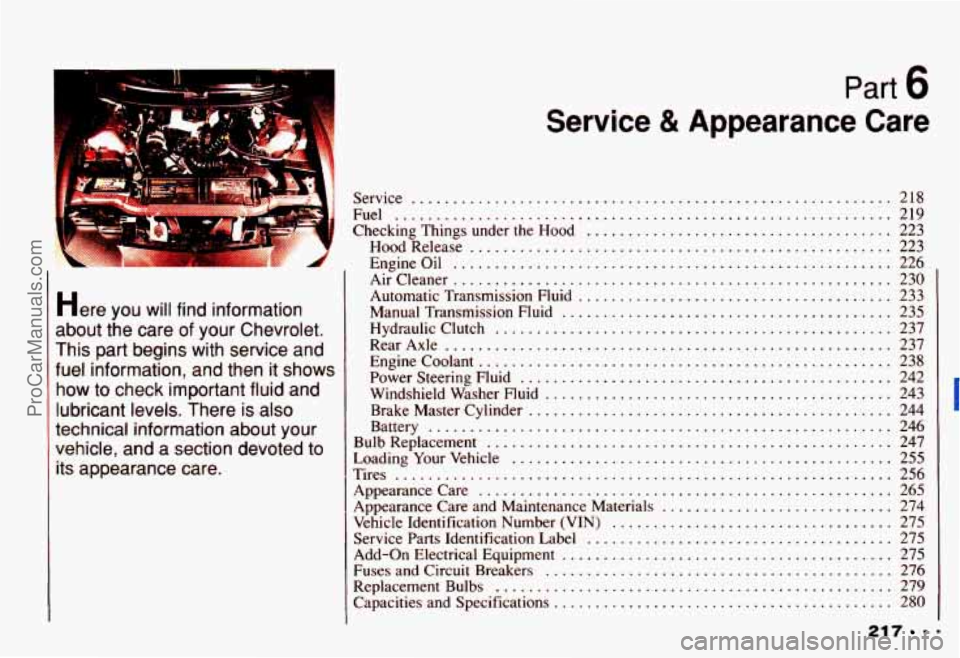
Part b
Here you will find information
about the care
of your Chevrolet .
This part begins with service and
fuel information. and then it shows
how
to check important fluid and
lubricant levels
. There is also
technical information about your
vehicle. and a section devoted to
its appearance care
.
Service & Appearance Care
Service .......................................................... 218
Fuel
............................................................ 219
Checking Things under the Hood
..................................... 223
HoodRelease
................................................... 223
Engineoil
...................................................... 226
Aircleaner
..................................................... 230
Automatic Transmission Fluid
...................................... 233
Manual Transmission Fluid
........................................ 235
Hydraulicclutch
................................................ 237
RearAxle
...................................................... 237
Enginecoolant
.................................................. 238
Power Steering Fluid
............................................. 242
Windshield Washer Fluid
.......................................... 243
Brake Master Cylinder
............................................ 244
Battery
........................................................ 246
Bulb Replacement
................................................. 247
Loading Your Vehicle
.............................................. 255
Appearance Care and Maintenance Materials
............................ 274
Vehicle Identification Number (VIN)
.................................. 275
Service Parts Identification Label
..................................... 275
Add-on Electrical Equipment
........................................ 275
Fuses and Circuit Breakers
.......................................... 276
Replacement Bulbs
................................................ 279
Capacities and Specifications
......................................... 280
Tires
............................................................ 256
Appearancecare
.................................................. 265
217
ProCarManuals.com
Page 222 of 358
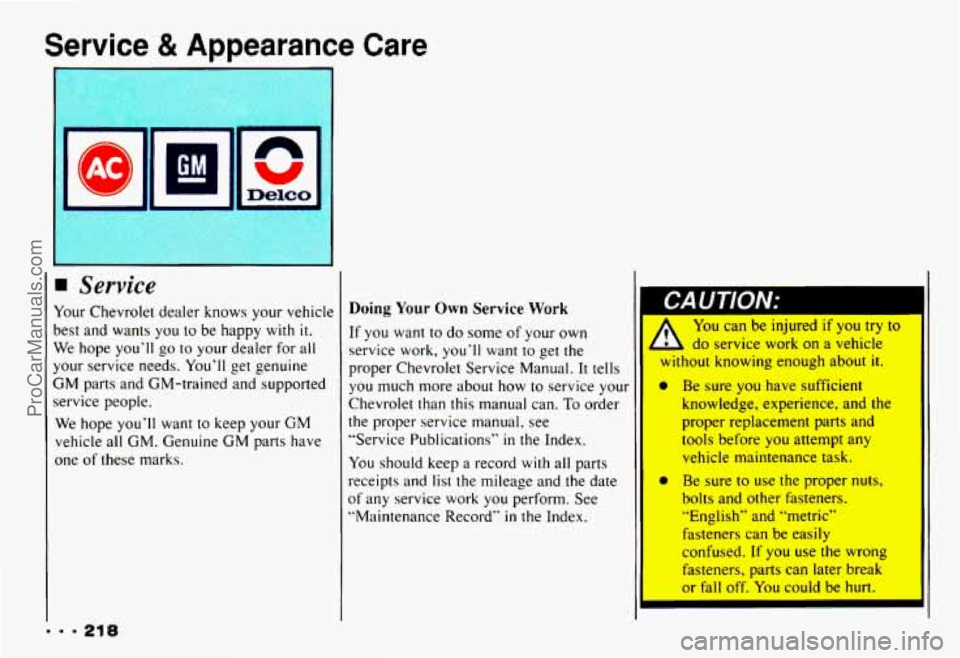
Service & Appearance Care
1
Service
Your Chevrolet dealer knows your vehicle
best and wants you
to be happy with it.
We hope you’ll
go to your dealer for all
your service needs. You’ll get genuine
GM parts and GM-trained and supported
service people.
We hope you’ll want to keep your GM
vehicle all GM. Genuine GM parts have
one
of these marks.
Doing Your Own Service Work
If you want to do some of your own
service work, you’ll want to get the
proper Chevrolet Service Manual. It tells
you much more about how
to service your
Chevrolet than this manual can.
To order
the proper service manual, see
“Service Publications”
in the Index.
You should keep
a record with all parts
receipts and list the mileage and the date
of any service work you perform. See
“Maintenance Record”
in the Index.
You can be injured if you try to
L do service work on a vehicle
hout knowing enough about it.
Be sure you have sufficient
knowledge, experience, and the
proper replacement
parts and
tools before you attempt any
vehicle maintenance
task.
Be sure to use the proper nuts,
bolts and other fasteners.
“English and “metric’”
fasteners can be easily
confused.
If you use the wrong
fasteners,
parts can later break
or fall
off. You couId be hurt.
ProCarManuals.com
Page 223 of 358
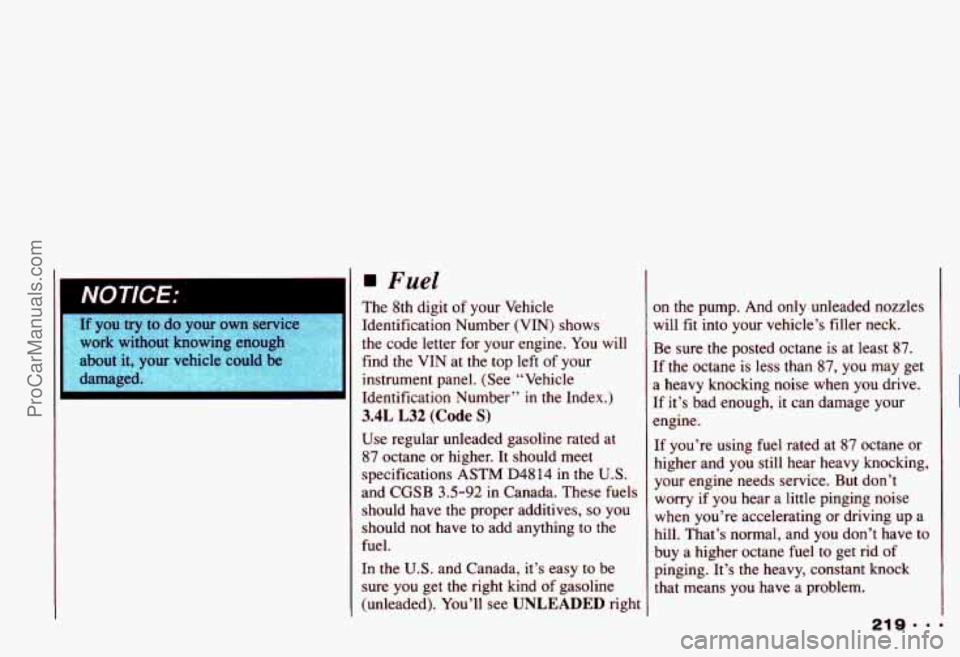
NOTICE:
Fuel
The 8th digit of your Vehicle
Identification Number (VIN) shows
the code letter for your engine.
You will
find the VIN at the top left
of your
instrument panel. (See “Vehicle
Identification Number” in the Index.)
3.4L L32 (Code S)
Use regular unleaded gasoline rated at
87 octane or higher. It should meet
specifications ASTM
D4814 in the U.S.
and CGSB 3.5-92 in Canada. These fuels
should have the proper additives,
so you
should not have to add anything to the
fuel.
In the U.S. and Canada, it’s easy to
be
sure you get the right kind of gasoline
(unleaded). You’ll see
UNLEADED right
In the pump. And only unleaded nozzles
will
fit into your vehicle’s filler neck.
Be sure the posted octane is at least 87.
:f the octane is less than 87, you may get
sl heavy knocking noise when you drive.
If it’s bad enough, it can damage your
engine.
If you’re using fuel rated at
87 octane or
higher and you still hear heavy knocking,
your engine needs service. But don’t
worry if you hear a little pinging noise
when you’re accelerating or driving up a
hill. That’s normal, and you don’t have to
buy a higher octane fuel to get rid of
pinging. It’s the heavy, constant knock
that means you have a problem.
ProCarManuals.com
Page 224 of 358
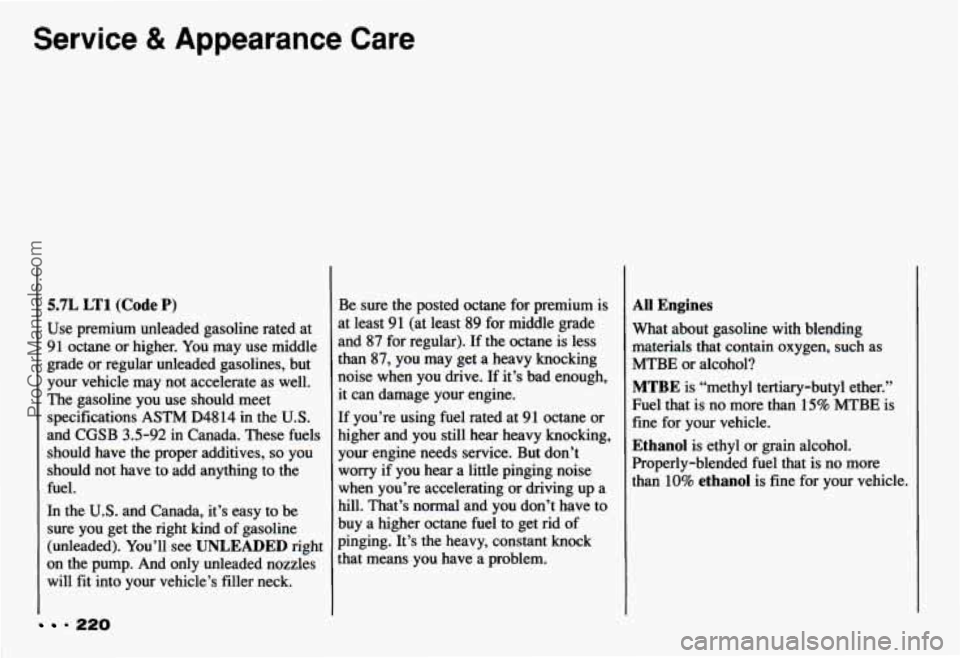
Service & Appearance Care
= 220
5.7L LT1 (Code P)
Use premium unleaded gasoline rated at
91 octane or higher. You may use middle
grade
or regular unleaded gasolines, but
your vehicle may not accelerate as well.
The gasoline you use should meet
specifications ASTM
D48 14 in the U.S.
and CGSB 3.5-92 in Canada. These fuels should have the proper additives,
so you
should not have to add anything to the
fuel.
In the
U.S. and Canada, it’s easy to be
sure you get the right kind of gasoline
(unleaded). You’ll see
UNLEADED right
on the pump. And only unleaded nozzles
will fit into your vehicle’s filler neck. Be
sure
the posted octane for premium is
at least 91 (at least
89 for middle grade
and
87 for regular). If the octane is less
than
87, you may get a heavy knocking
noise when you drive. If it’s bad enough,
it can damage your engine.
If you’re using fuel rated at 91 octane or
higher and you still hear heavy knocking,
your engine needs service. But don’t
worry if you hear a little pinging noise
when you’re accelerating
or driving up a
hill. That’s normal and you don’t have to
buy a higher octane fuel to get rid of
pinging. It’s the heavy, constant knock
that means you have a problem.
All Engines
What about gasoline with blending
materials that contain oxygen, such as
MTBE
or alcohol?
MTBE is “methyl tertiary-butyl ether.”
Fuel that is no more than 15% MTBE is
fine for your vehicle.
Ethanol is ethyl or grain alcohol.
Properly-blended fuel that is no more
than 10%
ethanol is fine for your vehicle.
ProCarManuals.com
Page 225 of 358
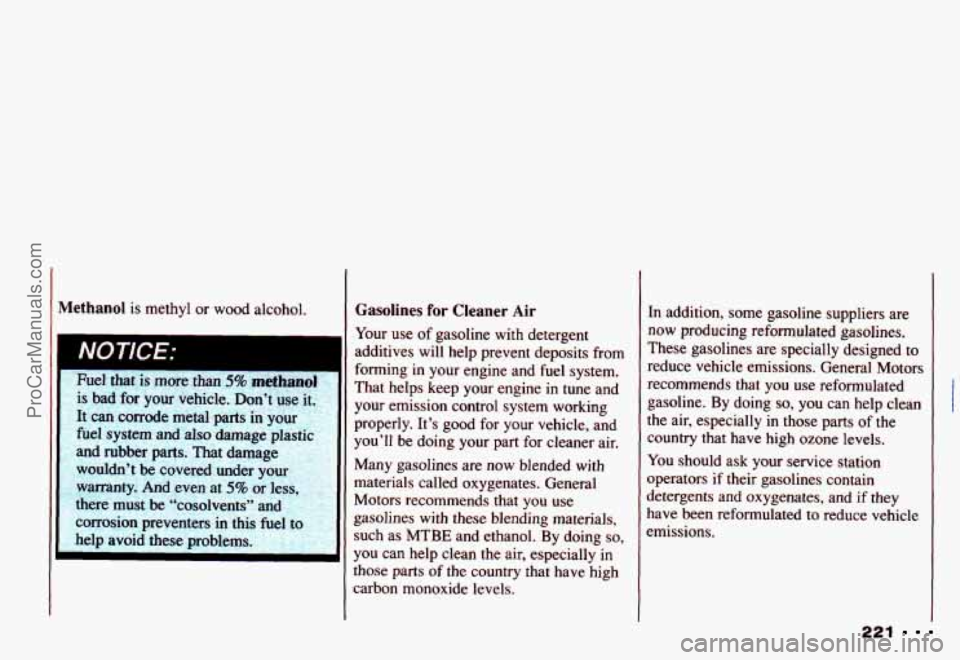
Methanol is methyl or wood alcohol.
IC
NOTICE:
I
rue1 mat is more than 3% metha
is bad for your vehicle. Don’t use it.
It can corrode metal parts in your
fuel system and also damage plastic
and rubber parts. That damage wouldn’t
be covered under your I
rranty. And even at 5% or less,
there must be “cosolvents” and
corrosion preventers in this fuel
to
help avoid these problems.
I
Gasolines for Cleaner Air
Your use of gasoline with detergent
additives will help prevent deposits from
forming
in your engine and fuel system.
That helps keep your engine in tune and
your emission control system working
properly. It’s good for your vehicle, and
you’ll be doing your part for cleaner air.
Many gasolines are
now blended with
materials called oxygenates. General
Motors recommends that you use
gasolines
with these blending materials,
such as MTBE and ethanol.
By doing so,
you can help clean the air, especially in
those parts of the country that have high
carbon monoxide levels. In
addition, some gasoline suppliers are
now producing reformulated gasolines.
These gasolines are specially designed to
reduce vehicle emissions. General Motors
recommends that you
use reformulated
gasoline.
By doing so, you can help clean
the air, especially
in those parts of the
country that have high ozone levels.
You should ask your service station
operators
if their gasolines contain
detergents and oxygenates, and if they
have been reformulated to reduce vehicle
emissions.
221
ProCarManuals.com
Page 226 of 358
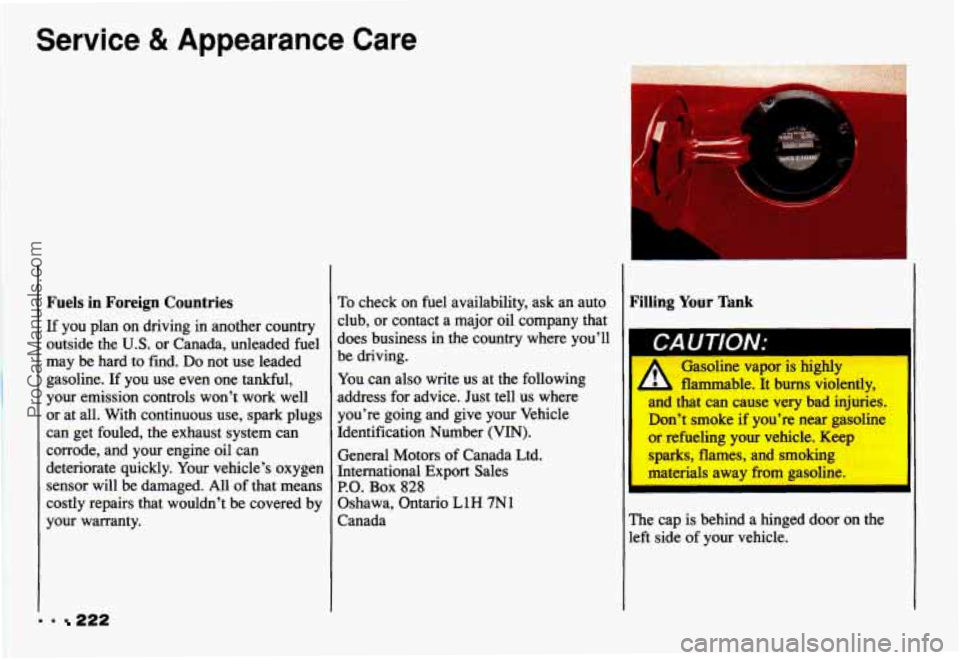
Service & Appearance Care
Fuels in Foreign Countries
If you plan on driving in another country
outside the
U.S. or Canada, unleaded fuel
may be hard to find.
Do not use leaded
gasoline.
If you use even one tankful,
your emission controls won’t work well or at all. With continuous use, spark plugs
can get fouled, the exhaust system can
corrode, and your engine oil can
deteriorate quickly.
Your vehicle’s oxygen
sensor will be damaged.
All of that means
costly repairs that wouldn’t be covered by
your warranty.
c L. 222
To check on fuel availability, ask an auto
club,
or contact a major oil company that
does business in the country where you’ll
be driving.
You can also write us at the following
address for advice. Just tell us where
you’re going and give your Vehicle
Identification Number (VIN).
General Motors of Canada Ltd.
International Export Sales
P.O. Box 828
Oshawa, Ontario L1H 7N1
Canada
I
Filling Your Tank
Gasoline vapor is highly
flammable. It burns violently,
and that can cause very bad injuries. Don’t smoke if you’re near gasoline
or refueling your vehicle. Keep
, sparks, flames, and smoking
C
materials away from gasoline.
‘I
The cap is behind a hinged door on the
left side of your vehicle.
ProCarManuals.com
Page 227 of 358
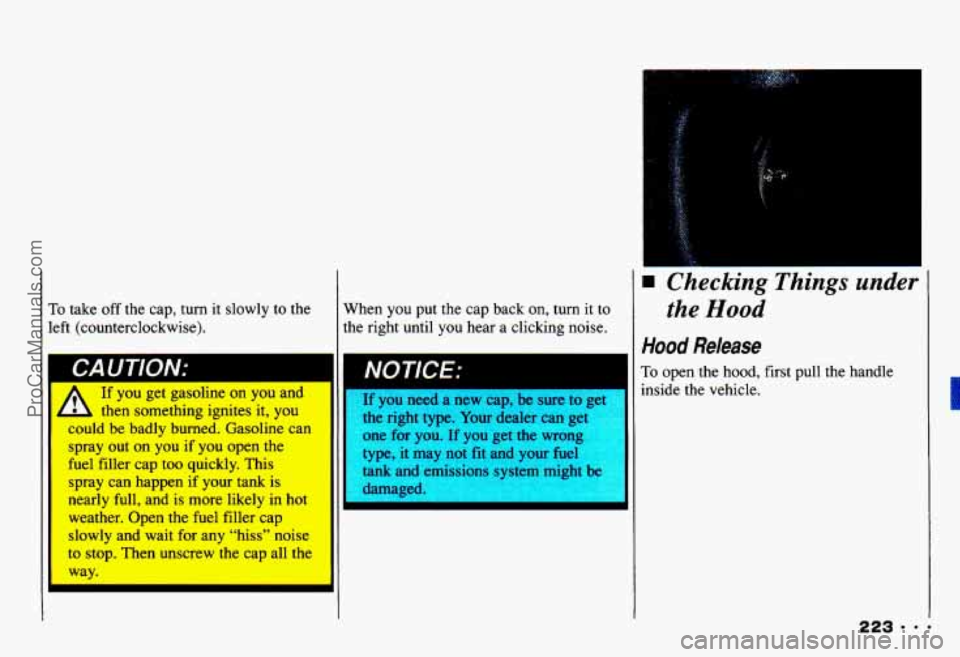
To take off the cap, turn it slowly to the
left (counterclockwise). When you put the
cap back on, turn it to
the right until
you hear a clicking noise.
I A If you get gasoline on you and
L then something ignites it, you
could be badly
burned. Gasoline can
spray out on you if you open the
fuel filler
cap too quickly. This
spray
can happen if your tank is
nearly full, and is more likely in
hot ~
weather. Open the fuel filler cap
slowly
and wait for any “hiss” noise
to stop. Then unscrew the cap all the
way.
I
1
If you _____1 need a new cap, be sure to get
the right type. Your dealer can get
one for you. If you get the wrong
type, it may not fit and your fuel
tank and emissions system might be -
I damaged.
Checking Things under
the Hood
Hood Release
To open the hood, first pull the handle
inside the vehicle.
223 9 9 9
ProCarManuals.com
Page 228 of 358
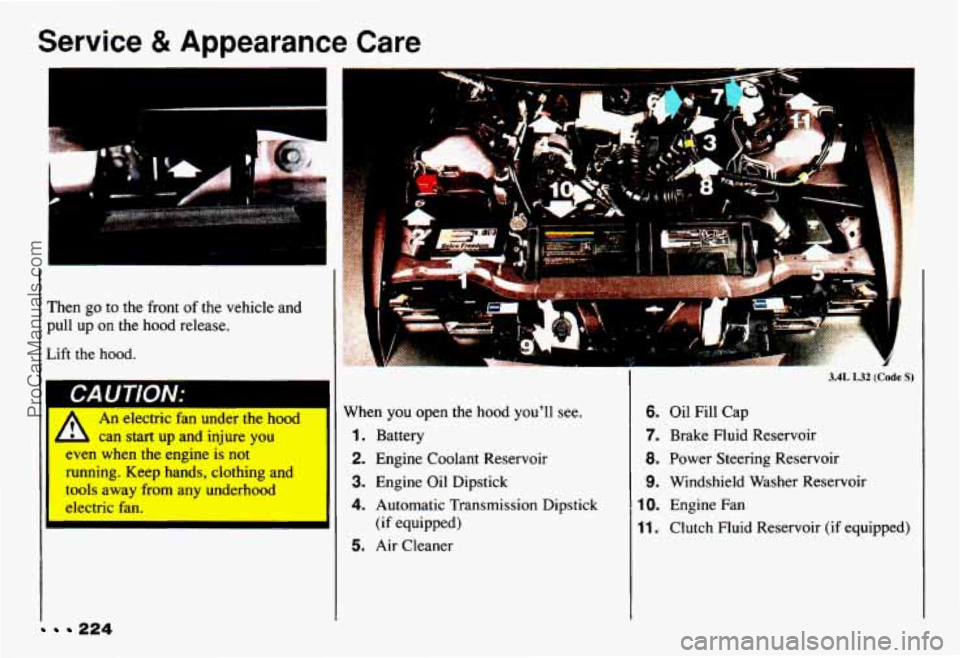
Service 8t Appearance Care
c
Then go to the front of the vehicle and
pull up on the hood release.
Lift
the hood.
I
I CAUTION:
An electric fan under the hood
can start up and injure you
even when
the engine is not
running. Keep hands, clothing and
tools away from any underhood
* xtric fan.
I
Y
3.4L L32 (Code S)
When you open the hood you'll see.
1. Battery
2. Engine Coolant Reservoir
3. Engine Oil Dipstick
4. Automatic Transmission Dipstick
5. Air Cleaner
(if equipped)
6. Oil Fill Cap
7. Brake Fluid Reservoir
8. Power Steering Reservoir
9. Windshield Washer Reservoir
10. Engine Fan
11. Clutch Fluid Reservoir (if equipped)
224
ProCarManuals.com
Page 229 of 358
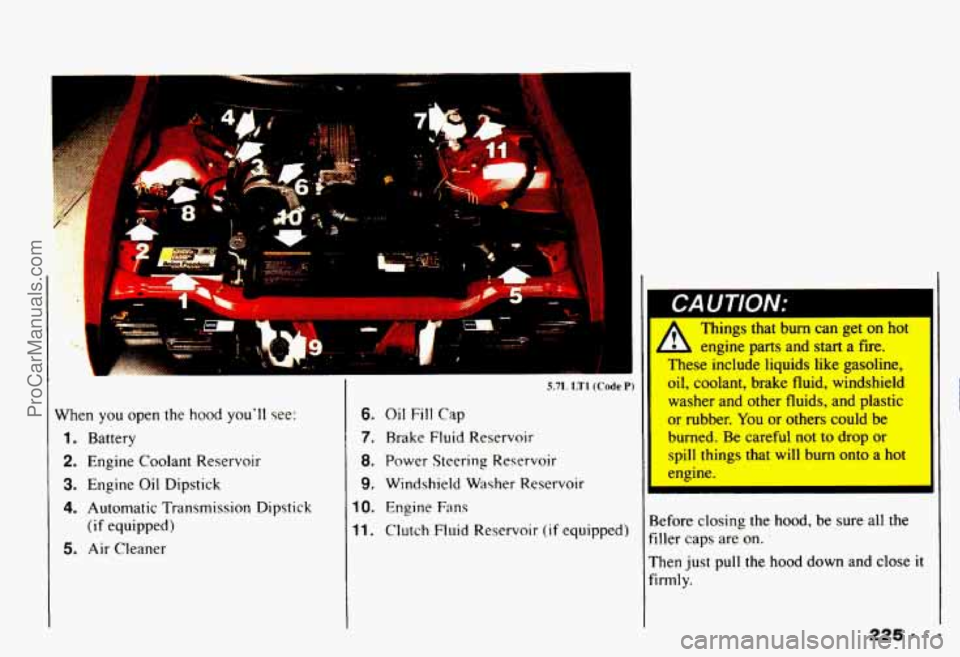
\I I
-:E= 1
f
I
When you open the hood you'll see:
1. Battery
2. Engine Coolant Reservoir
3. Engine Oil Dipstick
4. Automatic Transmission Dipstick
5. Air Cleaner
(if equipped)
II
6. Oil Fill Cap
7. .Brake Fluid
Reservoir
8, Power Steering Reservoir
9. Windshield Washer Reservoir
10. Engine Fans
11. Clutch Fluid Reservoir (if equipped) Things that
burn
can get on hot
b engine parts and start a fire.
mese include liquids like gasoline,
oil, coolant, brake fluid, windshield
washer and other fluids, and plastic
or rubber. You or others could be
burned. Be careful not to drop or
spill things that will burn onto a hot
ennine. 1
Before closing the hood, be sure all the
filler caps are on.
Then just pull the hood down and
close it
firmly.
ProCarManuals.com
Page 230 of 358
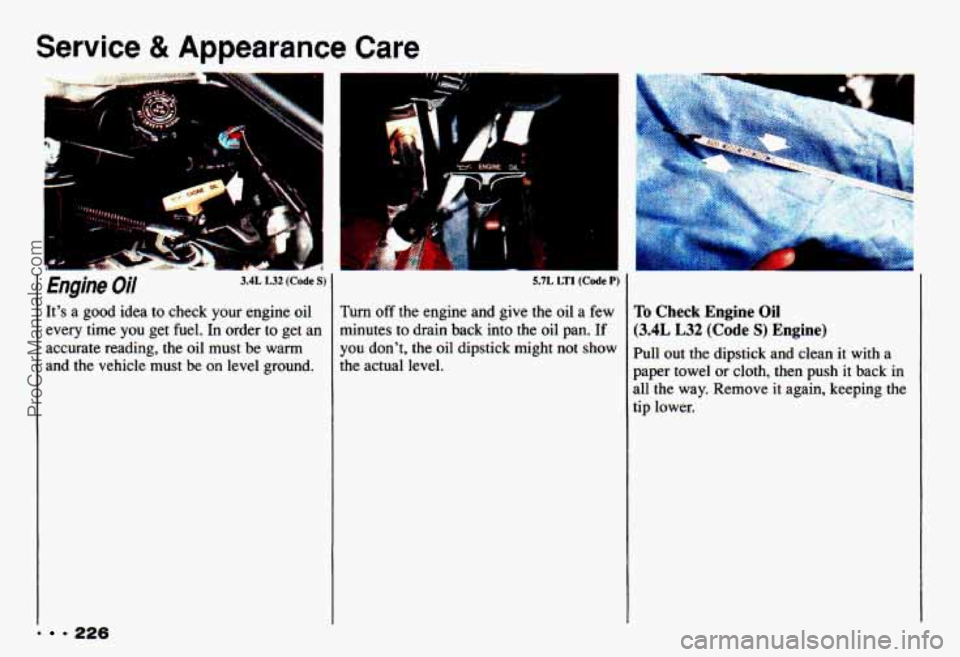
Service & Appearance Care
. = 226
Engine Oil 3.4L L32 (Code S)
It's a good idea to check your engine oil
every time
you get fuel. In order to get an
accurate reading, the oil must be warm
and the vehicle must be on level ground,
5.7L LTl (Code P)
Turn off the engine and give the oil a few
minutes to drain back into the oil
pan. If
you don't, the oil dipstick might not show
the actual level.
To Check Engine Oil
(3.4L L32 (Code S) Engine)
Pull out the dipstick and clean it with a
paper towel or cloth, then push it back in
all the way. Remove it again, keeping the
tip lower.
ProCarManuals.com